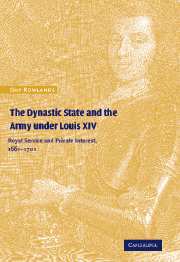Book contents
- Frontmatter
- Contents
- List of maps
- Acknowledgements
- List of abbreviations
- Family tree of the Le Tellier: 1. Principal branch
- Family tree of the Le Tellier: 2. Royal household marital connections
- Map 1 The French provinces under Louis XIV
- General introduction: ‘Absolute monarchy’, dynasticism and the standing army
- Part I ‘Patrimonial bureaucracy’: The Le Tellier dynasty and the Ministry of War
- Part II The forging of the French officer corps and the standing army under Louis XIV
- Part III The high command of the French armies
- Introduction
- 9 The commanders-in-chief and the delegation of royal authority
- 10 The appointment of general officers
- 11 The summits of ambition and the rewards of good service: the bienfaits du roi and the high command
- Conclusion: The preservation of the dynasty
- Appendix 1 Defining the grands
- Appendix 2 The proportion of revenue generated by the Extraordinaire des Guerres as a ‘primary receiver’
- Bibliography
- Index
- CAMBRIDGE STUDIES IN EARLY MODERN HISTORY
10 - The appointment of general officers
Published online by Cambridge University Press: 20 May 2010
- Frontmatter
- Contents
- List of maps
- Acknowledgements
- List of abbreviations
- Family tree of the Le Tellier: 1. Principal branch
- Family tree of the Le Tellier: 2. Royal household marital connections
- Map 1 The French provinces under Louis XIV
- General introduction: ‘Absolute monarchy’, dynasticism and the standing army
- Part I ‘Patrimonial bureaucracy’: The Le Tellier dynasty and the Ministry of War
- Part II The forging of the French officer corps and the standing army under Louis XIV
- Part III The high command of the French armies
- Introduction
- 9 The commanders-in-chief and the delegation of royal authority
- 10 The appointment of general officers
- 11 The summits of ambition and the rewards of good service: the bienfaits du roi and the high command
- Conclusion: The preservation of the dynasty
- Appendix 1 Defining the grands
- Appendix 2 The proportion of revenue generated by the Extraordinaire des Guerres as a ‘primary receiver’
- Bibliography
- Index
- CAMBRIDGE STUDIES IN EARLY MODERN HISTORY
Summary
It is not enough to have large armies on a footing, if they are not well led and well commanded, and … the consideration of good generals hardly contributes less to the strength of a State.
For any ambitious military noble serving the king the ultimate prize was to be appointed commander-in-chief of one of the royal armies. It was a highly demanding job, but the potential rewards it could generate for an individual and his family were great indeed. Very few generals were as self-effacing as Nicolas Catinat, and as deeply reluctant as he to exploit their position and good credit with the king to advance their relatives. For all that, there were around 20,000 nobles in military or naval service at the peak of mobilisation during the 1690s, yet only a handful of armies and fleets to command. Even for those who made it to the rank of general few could seriously expect to reach the very top of the ladder. Many were called, but few were chosen. This chapter will accordingly seek to explain the criteria by which Louis XIV made some of his appointments to command and his promotions to general rank, while the final chapter of this book will examine the means he deployed to encourage good service among his most senior officers.
- Type
- Chapter
- Information
- The Dynastic State and the Army under Louis XIVRoyal Service and Private Interest 1661–1701, pp. 296 - 317Publisher: Cambridge University PressPrint publication year: 2002



